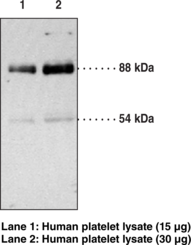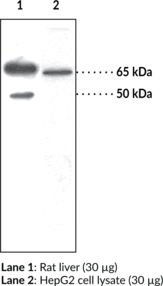Description
CD36 is a type-B scavenger receptor that is necessary for the formation of foam cells in atherosclerotic lesions.{7719,9800,9801,9795} This membrane glycoprotein can internalize fatty acids which activate PPARγ and stimulate further expression of CD36.{9798,8499} This positive feedback loop combined with the murine CD36 knock-out studies reinforces the importance of CD36 in lipid metabolism. Additionally CD36 is needed for the phagocytosis of P. falciparum infected erythrocytes, retinal pigment epithelial cell photoreceptor fragments, and post-apoptotic monocytes and neutrophils.{9794,9310,9793,9791} CD36 expression has been monitored during hematopoietic cell differentiation and may be an indicator of tumor spreading in lymphocytic leukemia.{9797} This transmembrane glycoprotein is detected by immunoblotting at 88 kDa or 54 kDa depending on the degree of glycosylation of the receptor in your sample. Positive controls include adipose and heart tissue, platelets, and macrophages.
Synonyms: GPIIIb|GPIV|Hexarelin Receptor|oxLDL Receptor|Thrombospondin Receptor
Immunogen: Synthetic peptide from an internal region of human CD36
Formulation: 500 µl of peptide affinity-purified antibody.
Isotype:
Applications: IHC and WB
Origin: Animal/Rabbit
Stability: 365 days
Application|Immunohistochemistry||Application|Western Blot||Product Type|Antibodies|Polyclonal Antibodies||Research Area|Cardiovascular System|Blood|Erythrocytes & Hemoglobin||Research Area|Cardiovascular System|Cardiovascular Diseases|Atherosclerosis||Research Area|Immunology & Inflammation|Innate Immunity|Phagocytosis||Research Area|Infectious Disease|Parasitic Diseases|Malaria||Research Area|Oxidative Stress & Reactive Species|Lipid Peroxidation



